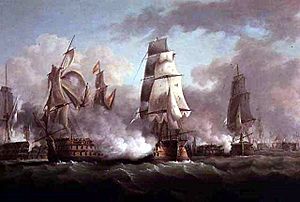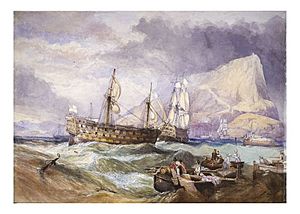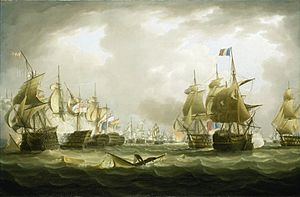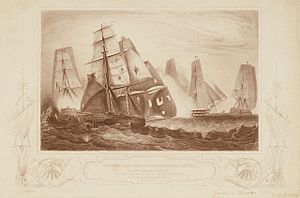HMS Neptune (1797) facts for kids

Neptune engaged, Trafalgar, 1805, by John Francis Sartorius. HMS Neptune, seen in bow profile, exchanges broadsides with the Spanish Santísima Trinidad
|
|
Quick facts for kids History |
|
|---|---|
| Name | HMS Neptune |
| Ordered | 15 February 1790 |
| Builder | Deptford Dockyard |
| Laid down | April 1791 |
| Launched | 28 January 1797 |
| Fate | Broken up in October 1818 |
| General characteristics | |
| Class and type | Neptune-class ship of the line |
| Tons burthen | 2,110 53⁄94 (bm) |
| Length | 185 ft (56 m) (gundeck) |
| Beam | 51 ft (16 m) |
| Depth of hold | 21 ft (6.4 m) |
| Propulsion | Sails |
| Sail plan | Full-rigged ship |
| Complement | 750 |
| Armament |
|
HMS Neptune was a powerful warship of the Royal Navy. She was a "98-gun second-rate ship of the line," meaning she carried 98 cannons and was a very large warship. She played a big part in the French Revolutionary Wars and Napoleonic Wars, especially at the famous Battle of Trafalgar in 1805.
Neptune was built when Britain was at war with France. She was launched in 1797. Soon after, she was involved in the Nore mutiny, a time when sailors protested their conditions. Luckily, the mutiny ended peacefully. Neptune then joined the main British fleet.
In 1799, she moved to the Mediterranean Sea. She spent the rest of the French Revolutionary Wars there. After some repairs, she joined Lord Nelson's fleet. She fought bravely at the Battle of Trafalgar, taking some damage and having 10 sailors killed and 34 wounded.
After more repairs, Neptune sailed to the Caribbean in 1807. In 1809, she helped invade Martinique, a French island. She also fought against a French naval group. Towards the end of the wars, she was put into storage. In 1813, she became a temporary prison ship. Neptune was finally taken apart in 1818.
Contents
Building HMS Neptune
Neptune was ordered on February 15, 1790. She was designed by Sir John Henslow. She was one of three ships of her kind, along with HMS Temeraire and HMS Dreadnought.
Work on Neptune began in April 1791 at Deptford Dockyard. She was named on July 24, 1790. The ship was launched on January 28, 1797. After launching, she sailed to Woolwich to be prepared for sea. This included adding her copper sheathing to protect the hull.
The total cost to build Neptune was about £77,053. This was a huge amount of money at the time! She was ready for duty on March 25, 1797. Captain Henry Edwyn Stanhope was her first commander. She was the third Royal Navy ship to be named Neptune.
Mutiny and Mediterranean Service
Soon after joining the fleet, Neptune faced a big challenge. Sailors at the Nore began a mutiny. Neptune was ordered to be ready to attack the rebellious ships. However, the mutiny ended before any fighting happened.
After this, Neptune joined the Channel Fleet. This fleet protected Britain's home waters. In 1798, there was a small mutiny among some of her crew. The sailors involved were put on trial.
In 1799, Neptune sailed to the Mediterranean Sea. She joined Lord Keith's fleet. Their job was to find and fight a large French and Spanish fleet. The enemy fleet managed to escape to Brest. Neptune stayed in the Mediterranean for the rest of the French Revolutionary Wars.
Blockade Duty and Trafalgar Approach
After the wars, Neptune returned to Britain. She underwent repairs and was ready for duty again. In 1802, Captain William O'Bryen Drury took command. She rejoined the Channel Fleet.
For the next two years, Neptune helped blockade French ports. This meant stopping enemy ships from leaving or entering. In 1805, Captain Thomas Fremantle became her commander. He joined Robert Calder's fleet, which was looking for the French fleet.
Eventually, the French fleet sailed into Cadiz, Spain. Neptune joined the British fleet blockading them there. Captain Fremantle thought Neptune was a slow ship. But during the upcoming battle, she surprised everyone by sailing very well!
The Battle of Trafalgar
On October 21, 1805, Neptune was part of the "weather column" at the Battle of Trafalgar. This was one of two lines of British ships attacking the enemy. She was the third ship in her line, behind HMS Temeraire and HMS Victory.
Captain Fremantle wanted to lead the line. But Lord Nelson, on HMS Victory, ordered Neptune to slow down. Nelson wanted to lead the attack himself. As Neptune went into battle, her band played music. Most of the crew lay down to protect themselves from enemy fire.
Neptune followed Victory towards the French flagship, Bucentaure. As she passed the Bucentaure's stern, Neptune fired a powerful broadside. This caused huge damage to the French ship. Fremantle then turned Neptune to fire more shots at the Bucentaure.
Next, Fremantle saw the giant Spanish four-deck ship, Santísima Trinidad. Neptune attacked her, firing her cannons. For an hour, Neptune and Santísima Trinidad fought fiercely. Other British ships also joined the attack.
The Santísima Trinidad was badly damaged. She lost her masts and was covered in debris. She finally surrendered after 5:30 pm. She had lost 205 sailors and had 103 wounded. Neptune then went to chase other enemy ships.
During the battle, Neptune took a lot of damage to her masts and rigging. Her hull was hit nine times. She had 10 sailors killed and 34 wounded. Only one officer was hurt.

After the battle, Neptune helped tow the damaged HMS Royal Sovereign. She also took on board the captured French Admiral Villeneuve. As a storm approached, Neptune helped rescue sailors from the sinking Santísima Trinidad. On October 26, Neptune took the badly damaged Victory in tow. She brought Victory, carrying Lord Nelson's body, safely to Gibraltar on October 28.
Service in the West Indies
After some repairs in Gibraltar, Neptune returned to Britain. She was put into storage for a while. In 1807, she was repaired again. She was recommissioned under Captain Sir Thomas Williams.
In 1808, Neptune sailed to the Caribbean. In January 1809, she became the flagship for an attack on Martinique. This was a French colony. The British force, with 44 ships and 10,000 soldiers, sailed on January 28.
The troops landed on Martinique on January 30. They faced little resistance. The French forces were pushed back into their forts. The last French fort surrendered on February 24, 1809.
Fighting Troude's Squadron
After the invasion, Neptune and other British ships blockaded Martinique. In March, a French squadron arrived in the Caribbean. It had three large warships and two frigates. They were led by Commodore Amable Troude.
Finding Martinique captured, Troude's ships anchored near Îles des Saintes. The British blockaded them there. On April 14, British troops landed on the islands and captured them. They set up heavy guns overlooking the French ships.
Threatened, Troude's squadron sailed away. Cochrane's British ships chased them. After several days of fighting, the French ship D'Hautpoul was captured. Neptune's captain, Charles Dilkes, was given command of the captured ship.
Neptune and the other British ships shared in the prize money from capturing the islands.
Final Years of Service
Captain Dilkes returned to command Neptune in March 1810. However, he was not well. Neptune returned to Plymouth in October. In November, she was put into storage.
Her hull began to wear out quickly. After a check, she was found unfit for sea duty. The Navy Board decided to turn her into a prison ship. This meant she would hold prisoners.
Work to convert her began in November 1813. It was finished in December. Neptune served as a prison ship for three years. Finally, in October 1818, she was taken apart.
|



